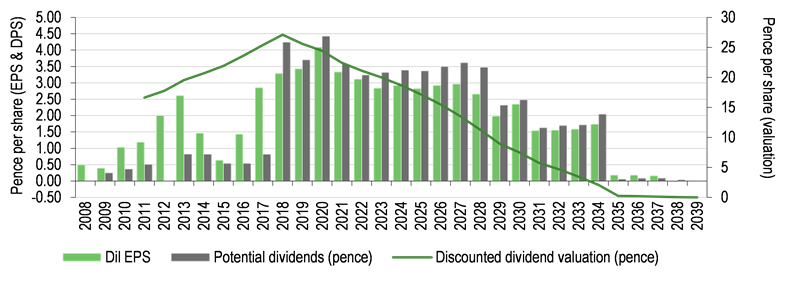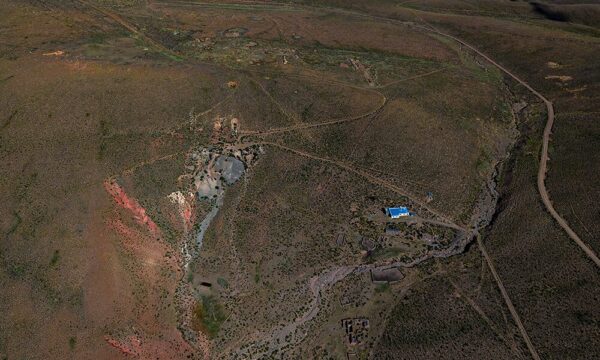Continuing its tradition, Pan African (PAF) has released a trading statement under paragraph 3.4 (b) of the JSE listing requirements in which it states that FY16 results will differ by at least 20% from those of the prior period (ie FY15).
Traditionally, PAF reports EPS and headline EPS, or HEPS (which principally excludes impairments), in accordance with South African practice. In this case, however, it has also provided an indication of normalised HEPS, which also excludes certain financial items. A summary of the financial instruments excluded from the normalised HEPS estimate (cf the HEPS estimate) for FY16 is as follows:
■
Zero cost collar: a mark-to-market loss relating to Barberton Mines’ strategic short-term hedge of ZAR82m (£4.2m, or 0.23p/sh post-Shanduka transaction), as at 30 June 2016.
■
A ZAR65.2m (£3.0m, or 0.17p/sh post-Shanduka transaction) post-tax cost relating to the cash settled effect of share option costs during the period.
■
A ZAR38.2m (£2.0m, or 0.11p/sh post-Shanduka transaction) reduction in the group’s rehabilitation liability as at 30 June and a ZAR9.4m (£0.5m, or 0.03p/sh post-Shanduka transaction) increase in its rehabilitation investment during the period.
In this case, PAF has indicated that headline EPS (HEPS) for FY16 will be 114-134% higher than the 0.65p per share reported in FY15 in sterling terms (ie in the range 1.37-1.50p) and that normalised HEPS (excluding financial instruments) will be 208-228% higher (ie in the range 2.00-2.13p). Among other things, the implication of the announcement is that the difference between EPS and HEPS is small and/or negligible.
In addition to its earnings guidance, Pan African also released production numbers for the full year. Overall production was 213,267oz of precious metals for the 12-month period, of which 204,928oz was gold and the balance was platinum group metals. This compared with management’s prior guidance of 209,000oz of precious metals for the full year and Edison’s forecast of 213,934oz of precious metals, including 204,653oz of gold. In addition, management reported 136,102t of coal produced from underground sources at the Uitkomst colliery (ie excluding coal bought in from third parties for blending and further processing). Uitkomst was acquired by Pan African on 1 April 2016 for a consideration of ZAR176m (gross of net working capital of ZAR26m), or £7.1m. Hitherto, Uitkomst has made a post-tax profit and an operational cash flow of c £1.6m (or 0.11p/share, post-the Shanduka transaction; see below) per annum. Production from Uitkomst is consolidated from 1 April 2016, although note that this is specifically excluded from Edison’s forecasts, which consider Pan African solely as a precious metals company.
A summary of Pan African’s individual operations’ outputs for the year compared with Edison’s prior forecasts is as follows:
Exhibit 1: Pan African mining operations’ production summary (actual vs forecast)
Operation |
2015 |
2016e |
Change (%) |
Prior Edison forecast (oz) |
Actual minus expected (oz) |
Barberton (oz) |
105,776 |
113,281 |
+7.1 |
110,315 |
+2,966 |
Evander (oz) |
70,081 |
91,647 |
+30.8 |
94,338 |
-2,691 |
Total gold (oz) |
175,857 |
204,928 |
+16.5 |
204,653 |
+275 |
Phoenix (oz) |
10,245 |
8,339 |
-18.6 |
9,281 |
-942 |
Total precious metals (oz) |
186,102 |
213,267 |
+14.6 |
213,934 |
-667 |
Source: Edison Investment Research, Pan African Resources
Edison’s interpretation of this production data is twofold:
■
the underground head-grade at Evander is likely to have been 6.32g/t (below the 6.75g/t expected, but still the highest since H213, when it was 7.59g/t); and
■
the metallurgical recovery at the Barberton Tailings Retreatment Project (BTRP) is likely to have remained high, at around 60%.
Shanduka transaction & Black Economic Empowerment (BEE)
On 1 June, Pan African advised shareholders that Jadeite had accepted Pan African’s offer to acquire its interest in Shanduka Gold, with the result that PAF purchased substantially all of Jadeite’s interest (33.0% of 33.6%) and Standard Bank’s interest (16.9%) in Shanduka Gold for a consideration of ZAR547m (£25.2m). A diagram of the ownership arrangement between Pan African, Shanduka Gold and the latter’s shareholders prior to the ‘Shanduka transaction’ is as follows:
Exhibit 2: Shanduka Gold shareholding structure (pre-transaction)
|

|
Source: Edison Investment Research, Pan African Resources
|
Shanduka Gold’s 23.8% interest in Pan African Resources is effectively its only asset, with the exception of a c ZAR500m vendor financed loan for Mabindu’s 49.5% interest in Shanduka Gold. As such, Pan African’s acquisition of Standard Bank’s and Jadeite’s interests in Shanduka Gold is, in effect, if not quite in reality, equivalent to a buy-back into treasury of its own shares. At the time of the transaction, the value of Shanduka Gold’s 23.8% shareholding in Pan African Resources would have been approximately ZAR1,391m (£64.3m) and the pro-rata values of Standard Bank’s and Jadeite’s combined interests in Shanduka Gold therefore c ZAR702m (£32.5m).
Mabindu is a black owned and controlled trust and is a “Historically Disadvantaged South African (HDSA)” entity for the purposes of South Africa’s BEE legislation. Shanduka Gold (and, indirectly, Mabindu) is Pan African’s primary BEE shareholder. Pursuant to legislation governing BEE and the granting and retention of South African mining licences and rights, Pan African is required to have a minimum level of HDSA ownership, to which Shanduka Gold contributes. The Shanduka transaction therefore ensures that Pan African’s current HDSA ownership structure is unaffected by retaining Shanduka Gold (and, indirectly, Mabindu) as shareholders.
From an accounting perspective, however, Shanduka Gold (post-transaction) is now deemed to be controlled by Pan African, with the result that Shanduka Gold’s full shareholding of 436,358,059 shares in Pan African will be eliminated upon consolidation for accounting purposes.
Mabindu’s 49.5% interest in Shanduka Gold was acquired at a discounted value, but created a notional loan, to be settled by Mabindu, in the amount of ZAR536m as at 11 December 2015. The notional loan accrues notional interest at the South African prime rate (currently 10.5%) plus 5% and is required to be notionally settled on 11 December 2018. While the notional loan is outstanding, 95% of dividends payable to Mabindu are waived and the notional loan is reduced by the aggregate value of all dividends paid and payable to Mabindu (estimated to be c ZAR24.7m relating to Pan African’s FY15 dividend, payable in December 2015).
At ostensibly the same time as the details of the Shanduka transaction became public, Pan African also announced a placing of 111,711,791 shares at ZAR3.25 (c 14.25p) per share – being a premium to the 30-day volume-weighted average traded price of Pan African shares as at 25 May 2016 – to raise a maximum of ZAR363m.
As a result of the above two transactions (the Shanduka transaction and the share placing), Pan African reports that the weighted number of shares in issue in FY16 was 1,811,427,377 (vs 1,831.5m previously) and that, all other things being equal, the number in issue in FY17 will be 1,506,848,495.
Investors should note that a draft Mining Charter has been published by the minister of mineral resources, which is intended to form the basis of future mining legislation. Comments by interested parties were submitted before 31 May and it is anticipated that there may be a number of significant amendments to this draft version of the charter following the submissions made by the mining industry. As a result, it is unclear in what form the final version of the charter will be published. Nevertheless, the Shanduka transaction should provide Pan African with flexibility in terms of ensuring compliance with any future BEE regulations.




















